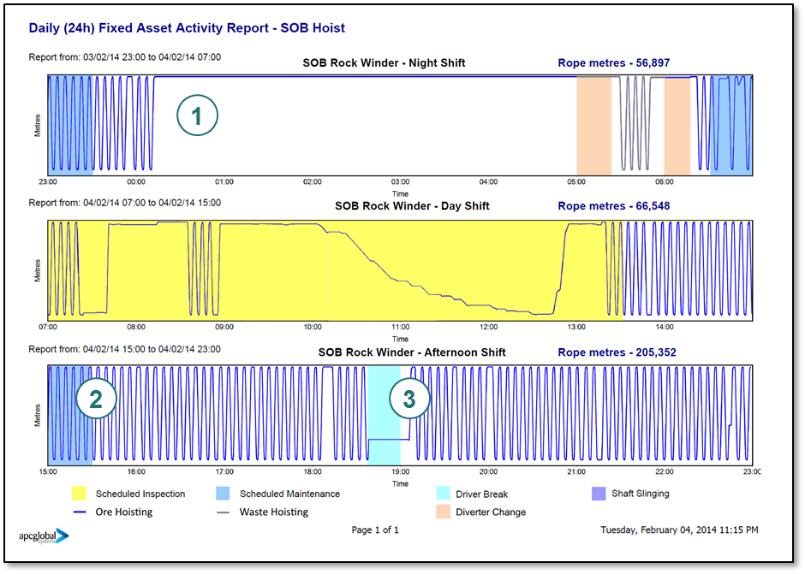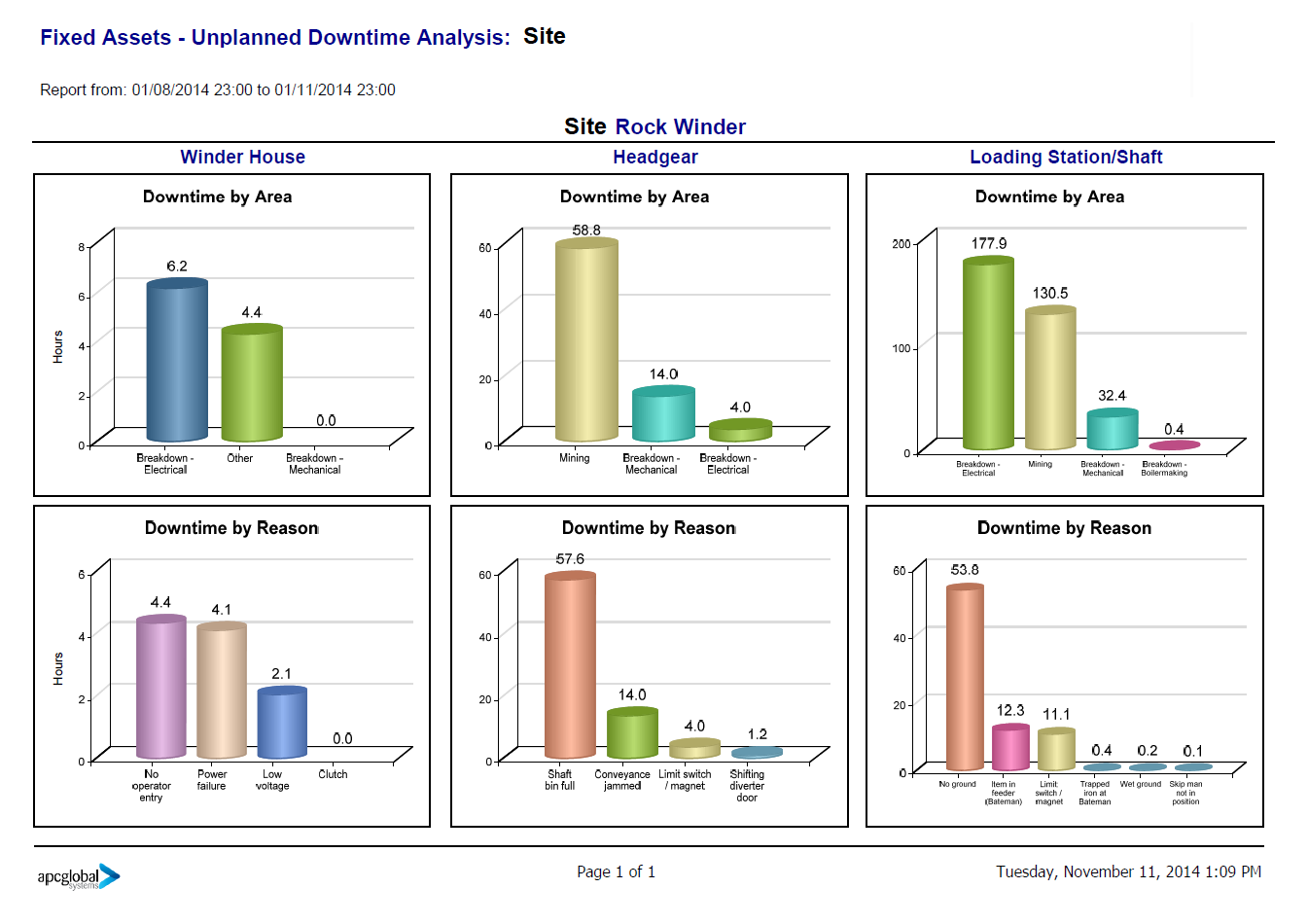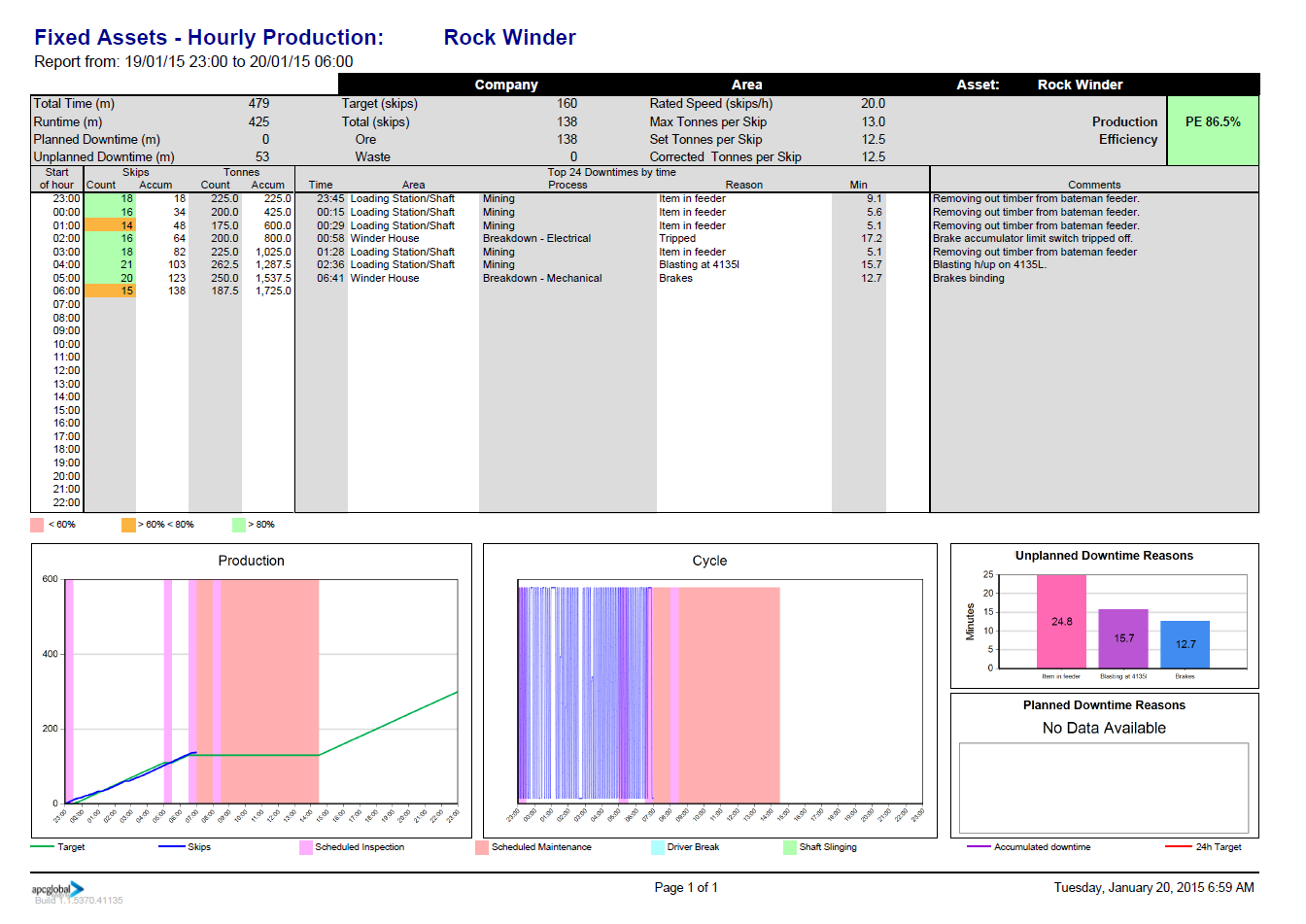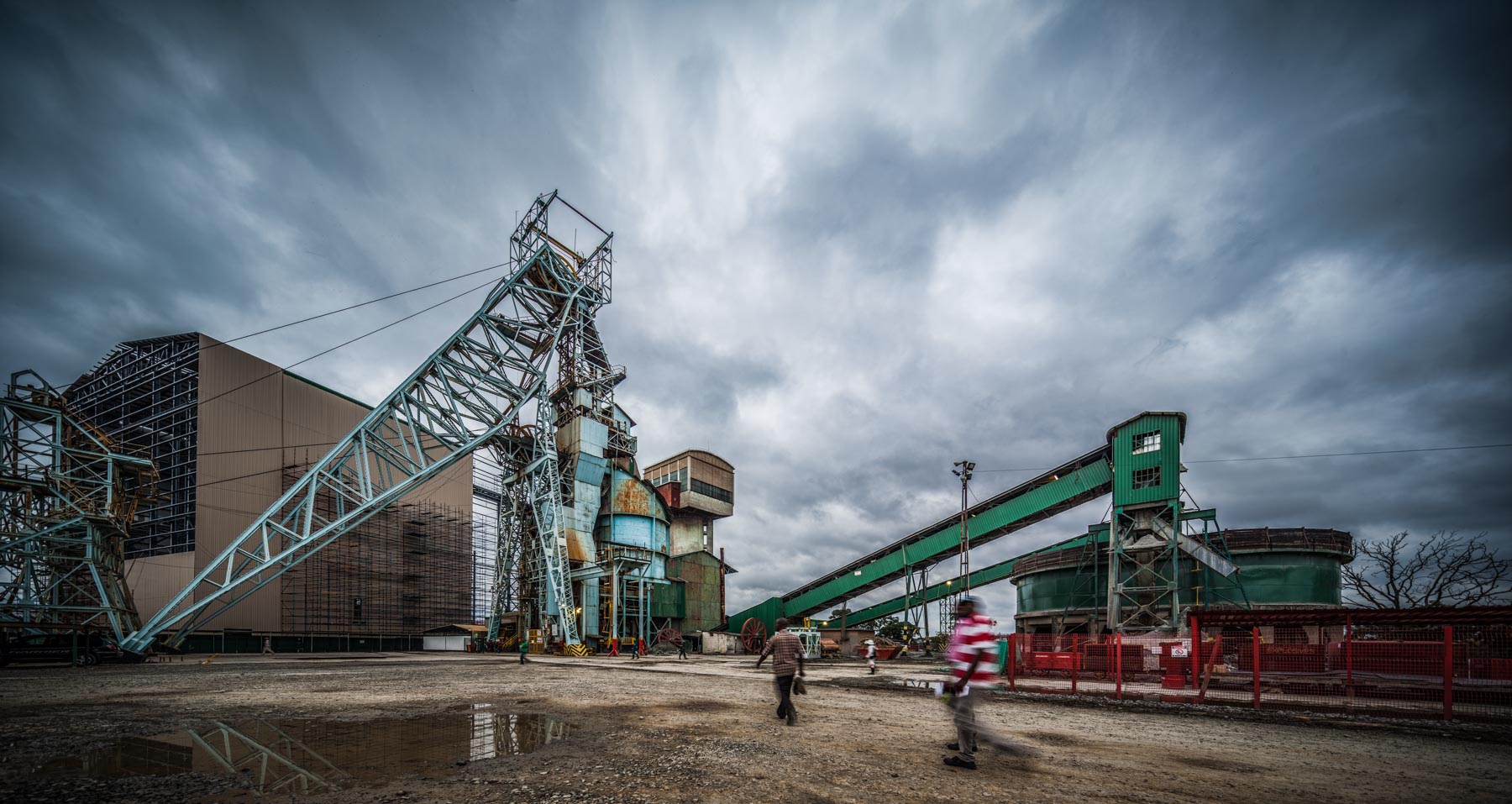Results
Increased hoist efficiency from 70.9% to 78.3%, average daily tonnes lifted from 3559t to 4663t, and improved average daily revenue by $125,000.
Tools
The tools being used for this case study are as follow
-
APC Productivity
Analysis (PA) -
Instrumented Hoists tachometer and slack rope monitoring
-
IP infrastructure
and cameras -
Visualisation Screens
Our client, Glencore Copper Africa, engaged APC to investigate a hoisting shaft that had an ageing infrastructure and performance below expectations. Reporting on the hoisting activity was manual and the information was inaccurate and 24 hours old. The choices were to perform a substantial upgrade of the hoist, or to improve the performance of the existing hoist, while not materially impacting production.
APC determined that the performance of the existing hoist could be improved, by deploying a real-time monitoring and tracking system that provided visibility, stoppage recording, and automated communication. The design criteria were rapidly installable, highly visible, and conducive to cultural change and sustainability.

Once the hoist was instrumented, APC PA was deployed to analyse the fundamentals of performance: cycle times, maintenance and operator influence. Through the visual management of hoist movement:
- Night shift performance was improved
- Statutory and non-statutory was observed, and
- Driver breaks were reduced to 20 minutes
The second phase was to improve the “Control Room Culture” – by providing tools to allow the rapid identification and response to stoppages. APC PA detects stoppages outside tolerance, and prompts for a reason. These reasons were standardised across the sites, allowing the development of a common response to issues.
Hourly reports are distributed to key personnel to track manager notification, actions, and resolution of downtimes.


Key Achievements
OPERATOR
Managed driver breaks to regulation time adding additional 20 minutes per day of hoisting time.
CYCLE TIMES
Increased skip cycle time from 19 skips per hour to 21 skips adding additional capacity of 20 hours x 2 skips x 12 tons = 400 tons per day.
MAINTENANCE
Reduction of Mechanical unplanned maintenance by 40%


l6nj6u
“Gorgeous nymphomaniac yearns for release.” Here — https://rb.gy/8rrwju?noippig
how to spot fake shoes nike – what are replica shoes
???????? ?? ????? ?????? ??? ?????? ?? ????? . ?????? ??? ??????? ?? ???? ??????? ?????? ??????? . ??? ??? ? ??? ?? ???? ?????? ???????? ???????? ???.
?? ???? ?????????? ???? ?????? ?? ?????. ?????? ?? ????? ??????? ???????? ?? ??????? ??????????? . ????? ??? ?????? ????? ?????? ??? ?? ?????.
?? ????? ?? ????? ????? ????? ????? ?????????? ????????? ???? ?? ???? ????? ????????? . ??? ????????? ??????? ?? ???????? ??????.
??????? ??? ???? ???????? ?? ???? ????, ????? ?? ??? ??????? ????? ??. ???? ?? ????? ???????? ??? ?? ???? ?????? ???? ?????? ?????.
betfinal https://betfinalafrica.com/
is there a central perk in nyc – replica designer bags
Сертификат ТР ТС 010/2011 – это документ, подтверждающий соответствие оборудования требованиям Технического регламента Таможенного союза “О безопасности машин и оборудования”. Этот регламент является одним из ключевых документов, определяющих требования к продукции, выпускаемой в обращение на территории стран Евразийского экономического союза (ЕАЭС).
Получение сертификата ТР ТС 010/2011 является обязательным условием для законного оборота широкого спектра оборудования, используемого в различных отраслях промышленности. К такому оборудованию относятся станки, прессы, конвейеры, насосы, компрессоры, подъемные механизмы и многое другое. Наличие сертификата свидетельствует о том, что оборудование прошло необходимые
испытания и соответствует высоким стандартам безопасности, установленным регламентом. Расскажите как сертификат тр тс 010 2011
eu9 download offers unique opportunities for gambling and entertainment in the heart of the online casino.
Loyalty programs and ongoing promotions ensure that players feel appreciated at the eu9 casino.
зимний футбол томск
100 super hot free slot https://100-super-hots.com/ awaits you with exciting moments and the chance to win big!
Don’t be afraid to mix and match styles to create personalized looks that represent you.
Скачайте 1xbet скачать на андроид бесплатно на русском на телефон последняя версия полная и начните играть прямо сейчас!
Пользователи могут обратиться за помощью в любой момент времени.
موقع betfinal https://luxurinaspa.com/betfinal-%d8%a7%d9%84%d9%85%d9%88%d9%82%d8%b9-%d8%a7%d9%84%d8%b1%d8%b3%d9%85%d9%8a-%d9%84%d9%84%d9%83%d8%a7%d8%b2%d9%8a%d9%86%d9%88-%d9%88%d8%a7%d9%84%d8%b1%d9%87%d8%a7%d9%86%d8%a7%d8%aa-%d8%a7%d9%84/
يُعتبر betfinal online casino الخيار المثالي للاعبين في السعودية بفضل تنوع الألعاب وسهولة الاستخدام.
يقدم betfinal casino تجربة لعب آمنة وسريعة مع دعم طرق الدفع المناسبة للاعبين العرب.
يحتوي الموقع على مئات الألعاب بما في ذلك اللايف dealer إضافة إلى قسم الرياضة المخصص لعشاق الرهانات الرياضية.
“Gorgeous nymphomaniac yearns for release.” Here — https://rb.gy/8rrwju?noippig
Thank you:)
https://www.youtube.com/@SupremeAudiobooks
Всем привет!
Хочу обсудить вопрос ремонта гидравлических насосов — может, кто-то поделится опытом.
Недавно начал замечать, что насос (аксиально-поршневой, стоит на мобильной технике) стал работать нестабильно. Давление то нормально, то «проваливается», как будто насос не может создать нужный поток. При этом появился лёгкий металлический стук, особенно когда повышаю нагрузку. Масло чистое, менялось вовремя, фильтры тоже новые.
Разобрался только до того, что проблема точно не в гидролиниях: утечек нет, соединения сухие, ничего не подсасывает воздух. Система греется сильнее обычного — температура масла выросла примерно на 10–15 градусов.
По симптомам похоже либо на износ пары наклонного диска, либо на проблемы с блоком цилиндров, но без разборки не понять. Сам лезть внутрь всё ещё сомневаюсь — слишком много нюансов, можно сделать хуже. Подскажите где лучший гидронасос komatsu
Приветствую, искатели рождественского чуда! В преддверии самых сказочных дней в году, когда сердце замирает в ожидании волшебства, я хочу поделиться с вами секретом идеальной новогодней ели. И имя ей – величественная пихта Нордмана!
Забудьте о мимолетной красоте и осыпающихся иголках! Нордманская пихта – это долговечность и элегантность в одном флаконе. Представьте себе: стройная красавица с густой, насыщенной зеленью, которая гордо возвышается в вашей гостиной, озаряя все вокруг своим благородством. Ее мягкие, неколючие иголки так приятно трогать, а ветви идеально расположены для украшения любыми игрушками. Подскажите где датская елка пихта нордмана
are fake shoes made in china – are replica shoes fake
40 super hot free games offers incredible chances to win and an exciting gaming experience!
Regardless of whether one sees it in a positive or negative light, its impact is clear.
Всем привет, рукодельницы и рукодельники! Решила, наконец, окунуться в волшебный мир вязания. И вот тут столкнулась с тем, что выбор пряжи – это задача уровня “миссия невыполнима”.
На полках магазинов – настоящая вавилонская башня: шерсть, акрил, хлопок, лен, шелк, смесовки, мохер, альпака… ах, да, еще и толщина разная, метраж, фактура, цвет! Глаза разбегаются, мозг закипает.
И вроде бы, информации в интернете хватает, но советы часто противоречат друг другу. Кто-то хвалит только дорогую мериносовую шерсть, кто-то утверждает, что для начинающих акрил – самое то. А я вот запуталась совсем.
В общем, проблема такая: хочу связать кардиган на лето. Но какую пряжу выбрать, чтобы было и приятно вязать, и чтобы результат порадовал, а не заставил рыдать над кривоварым полотном? Подскажите подойдет ли кавказская пряжа купить
Immerse yourself in the exciting world crazy time monopoly live, where every spin can be a turning point in your game!
This game is perfect for those who love both Monopoly and the thrill of live casino wagering.
888starz uz — o’yinlar va sport tikishlari uchun. Ushbu sayt. Har kim. platformada.
888starz отзывы 888starz отзывы
ishonchli tikish platformasi sifatida. qulay interfeysda. Platforma juda intuitiv. yordam beradi.
foydalanuvchilari uchun. tikish jarayonini. Yangi foydalanuvchilar. doimiy foydalanuvchilarga.
888starz uz. ularni. mumkin.
????? ?? betfinal ????? ??? ???????. ???? ?? ??????? ????? ?????????. ???? ?? ???? ???? ?????? ?? ???????? ???????.
?? ?? ?? ?????? ????? ??????? ???????? ?? betfinal. ???? betfinal ?????? ????? ?? ???????. ???? ?? ??? ?? ??????? ?????????? ??? ??????? ???????.
{betfinal https://betfinalafrica.com/
“Tempting tease longs for ecstasy.” Here — rb.gy/8rrwju?lolve
https://mega-store.asia/ – NEW WEBSITE HERE!!! mega HERE
Open the doors to the world of gambling entertainment and enjoy the game online ivibet casino!
One of the key attractions of ivibet is its extensive game library.
Складские позиции.
Грузоподъемность от 200 до 8000 кг Высота подъема от 1100 до 6000 мм.
Команда профессионалов EdmoLift всегда готова предоставить экспертную консультацию и помощь в выборе подъемного стола, наиболее подходящего для ваших конкретных потребностей. Компания EdmoLift всегда гарантирует качество своей продукции, а также предоставляет широкий спектр сервисных услуг, включая обслуживание и техническую поддержку, чтобы обеспечить бесперебойную работу вашего оборудования. В Москве всегда поддерживается запас наиболее востребованных запасных частей к подъемным столам любого года выпуска.
Тележка с подъемной платформой предназначена для работы в складских помещениях, производственных предприятий для транспортировки коробок, инструментов и других грузов. Способны поднимать и перемещать грузы весом до 1т на высоту до 1700мм.
Грузоподъемность, кг 800 Высота подъема, мм 1500 Размер платформы (ДхШ), мм 1200×610.
Арт. 700143.
Entdecken Sie die Welt der Glucksspielunterhaltung mit boomerang questions – Ihre ideale Wahl fur Wetten!
Die Flexibilitat der Wette ist ein entscheidender Faktor fur den Erfolg der Boomerang-Wette.
These incentives are designed to attract new players and retain existing ones.
1win download apk https://1win-download.org.in/
Selling your home for money and renovating estates for profit generally highly effective approach to produce income in the housing sector. Still, it requires meticulous organization and preparation. With the right methods, you can boost your opportunities of success and attain significant profits. With such a great discussion, we shall explore in thoroughly the actions you require to take to offer your house promptly for funds and revolve properties for income.
Starting, it’s essential to ascertain the sector worth of the property before offering it for cash. Knowing its value will assist you set an suitable requesting cost and formulate knowledgeable decisions around the marketing process. actually actually possible to determine your estate’s marketplace worth by engaging a certified evaluator, comparing your property to alike residences that have newly sold in your region, or using web-based appraisal resources fancy RealEstate.com.
The moment you could have established your home’s market value, really essential to cost it correctly. Setting a cost that will be undervalued can lead in economic loss, while valuing it overvalued may result to a prolonged selling process. To prevent these issues, set a competitive price based on the existing marketplace conditions. Engaging a housing broker to ensure their opinion regarding the most effective value for your property may be able to be advantageous.
If you decide you prefer to master more info on this article topic see our business:
how to sell a house fast for cash
The Truth About “We Buy Houses” Companies in Georgia 07f8_f9
Замена окон – это инвестиция в комфорт и энергоэффективность вашего дома, способная преобразить не только его внешний вид, но и атмосферу внутри. Старые, изношенные окна не только портят эстетику фасада, но и создают серьезные проблемы, такие как сквозняки, потеря тепла и повышенный уровень шума.
Замена окон является сложным и ответственным процессом, требующим профессионального подхода. Важно не только выбрать качественные окна, но и правильно установить их, чтобы обеспечить герметичность и долговечность конструкции. Ошибки, допущенные на этапе монтажа, могут привести к негативным последствиям, таким как образование конденсата, промерзание и преждевременный износ окон. Подскажите в каких случаях нужна замена стекла в окнах с деревянной рамой
Одной из главных особенностей 888starz uz является его удобный интерфейс.
888starz официальный сайт uz https://888starz2.ru/
Insatiable minx desires to upload racy photos. Here — rb.gy/8rrwju?lolve
Всем привет!
Попал в неприятную историю — побывал в аварии, и моя машина теперь в таком состоянии, что восстанавливать её просто нет смысла. Кузов повело, половина узлов разбита, да и по деньгам ремонт выходит дороже, чем она стоила до ДТП. Страховка часть покрыла, но авто осталось на мне, и вот теперь стоит вопрос: что с ним делать дальше?
Смотрю в сторону варианта продать машину на запчасти, но никогда этим не занимался. Вижу, что есть компании, которые забирают авто целиком, есть частники, которые выкупают определённые детали, кто-то вообще предлагает разбор на месте. Но как понять, кто действительно честно оценивает, а кто пытается сбить цену? И подойдут ли огрнацизации предлагающие автомобили на запчасти
Discover a world of excitement and entertainment true fortune casino no deposit bonus!
At True Fortune Casino is a popular destination for players looking for an exciting gaming experience. With a wide variety of games, it caters to both casual players and high rollers. Including everything from slots to various table games, there is something for everyone.
Дизайнерская мебель премиум класса — это воплощение изысканного стиля и безукоризненного качества.
Элитная мебель отличается индивидуальностью и высоким качеством исполнения. Каждый предмет создается ограниченным тиражом или является единственным экземпляром.
зеркало 888starz – это надежный способ получить доступ к любимым играм даже в случае блокировок.
888starz придерживается всех норм, касающихся защиты игроков.
يمكن للمستخدمين اختيار من بين مجموعة متنوعة من الألعاب المتاحة.
888starz ШЄЩ†ШІЩЉЩ„ https://888starz-casino-egypt.com/apk/
Furthermore, a generous introductory bonus. These bonuses and try out the offerings. These promotions for a beneficial experience in the online gaming arena.
Support services of 888starz casino. live chat, online correspondence, or a call. are prompt, allowing players to solve issues swiftly. Such support.
To conclude, maintaining secure and fair gameplay. Using, users can be assured of their safety while enjoying their gaming experience. ensures in every game, establishing credibility in the digital gambling world.
888starz free promo code https://888starz-bettings.com/promocode/
Химическая, пищевая промышленность и фармацевтика. Устойчивы к коррозии.
Столы с одинарными ножницами.
Грузоподъемность: 4000 кг.
Грузоподъемность: 300 кг.
Команда профессионалов EdmoLift всегда готова предоставить экспертную консультацию и помощь в выборе подъемного стола, наиболее подходящего для ваших конкретных потребностей. Компания EdmoLift всегда гарантирует качество своей продукции, а также предоставляет широкий спектр сервисных услуг, включая обслуживание и техническую поддержку, чтобы обеспечить бесперебойную работу вашего оборудования. В Москве всегда поддерживается запас наиболее востребованных запасных частей к подъемным столам любого года выпуска.
Арт. 700059.
Всё о камерах видеонаблюдения — полное руководство!
Приветствуем вас, уважаемые форумчане! Сегодня мы подробно поговорим обо всём, что касается видеокамер наблюдения. Мы поможем вам разобраться в огромном разнообразии предложений рынка и сделать правильный выбор оборудования для защиты вашего имущества и безопасности вашей семьи.
Почему важно установить систему видеонаблюдения?
Камеры видеонаблюдения становятся всё популярнее среди владельцев домов, офисов и коммерческих помещений. Они обеспечивают защиту имущества, предотвращают преступления и помогают контролировать происходящее даже дистанционно. Давайте рассмотрим самые важные аспекты выбора камеры и её установки.
Какие бывают виды камер видеонаблюдения?
Вы можете выбрать камеру исходя из ваших потребностей и условий эксплуатации:
– **Уличные** — предназначены для наружной установки, защищены от влаги и пыли.
– **Домашние** — компактные модели для внутренней установки.
– **IP-камеры** — позволяют подключаться к сети Интернет и просматривать записи онлайн.
– **Wi-Fi камеры** — удобны благодаря беспроводному соединению.
– **Камеры с SIM-картой** — работают независимо от интернета, передавая сигнал через мобильную сеть.
– **Миниатюрные камеры** — незаметны и подходят для скрытого наблюдения.
– **Поворотные камеры** — способны охватывать большие площади, поворачиваясь на 360 градусов.
– **Ночные камеры** — оснащены инфракрасной подсветкой для съёмки в темноте.
—
Как правильно выбрать камеру видеонаблюдения?
Перед покупкой обратите внимание на следующие характеристики:
– Разрешение камеры — HD/FullHD/UHD обеспечит чёткое изображение.
– Угол обзора — широкий угол позволяет видеть больше пространства.
– Наличие микрофона и динамика — возможность двусторонней связи.
– Датчик движения — экономия памяти устройства путём включения записи только при обнаружении активности.
– Питание — проверьте совместимость с вашим источником питания.
– Возможность удалённого доступа — управление камерой через смартфон или компьютер.
—
Установка и подключение камеры видеонаблюдения
Правильная установка и настройка камеры позволят вам эффективно пользоваться всеми возможностями системы видеонаблюдения. Рассмотрим ключевые моменты:
– Выберите оптимальное место для размещения камеры, обеспечивающее максимальный обзор охраняемой территории.
– Убедитесь, что камера защищена от погодных воздействий, если устанавливается снаружи здания.
– Настройте Wi-Fi соединение или кабельную линию подключения.
– Установите приложение для просмотра записей и управления камерой через мобильное устройство.
—
Где лучше всего приобрести камеру видеонаблюдения?
При покупке обращайте внимание на проверенные магазины и бренды. Рекомендуем выбирать оборудование известных производителей, предлагающих гарантии качества и поддержку клиентов. Обратите внимание на предложения крупных торговых площадок, таких как Ozon, Wildberries и специализированные магазины электроники.
—
Советы по установке камер видеонаблюдения:
– Изучите правила установки камер видеонаблюдения перед началом монтажа.
– Получите согласие жильцов многоквартирных домов на установку камер в подъездах и местах общего пользования.
– Позаботьтесь о защите личной жизни соседей, устанавливая камеры таким образом, чтобы избежать нарушения частной собственности.
—
Поделитесь своим опытом!
Расскажите нам о вашем опыте покупки и установки камер видеонаблюдения. Может быть, у вас есть советы или рекомендации для новичков? А может, вы столкнулись с проблемами при выборе или настройке оборудования? Оставляйте комментарии ниже, давайте делиться полезными советами вместе!
Автор:
Система видеонаблюдения
*Данная статья носит информационный характер и предназначена исключительно для ознакомительных целей.*
Wicked temptress needs to expose her bare flesh. Here — rb.gy/8rrwju?lolve
Сегодня не лучший день разбила свою BMW
Я ехал по знакомой дороге на своей «БМВ» после дождя. На повороте машину занесло на мокром асфальте, я не успел выровнять. Произошёл удар — передняя часть смялась, фара разбита. Я не пострадал, но машину разбил. Подскажите, может выкуп машин на разбор
Players often commend its intuitive layout and visually appealing aesthetics.
88starz https://www.carolinestorefinder.com/
With its user-friendly interface, it attracts many enthusiasts.
bet starz https://888starz-eng.com/fr/
Players can contact support through different means, which ensures their questions are answered promptly.
888starz bet live https://photalife.com/
The platform’s easy-to-navigate layout draws in a large audience of players.
888starz login https://888starz-eng.com/fr/
Kaixo, zure prezioa jakin nahi nuen.
Вы можете оценить товар.
Не важно, нужен ли вам подъемный стол для производства, складских операций или обслуживания оборудования, компания EdmoLift имеет отличный опыт и экспертизу, чтобы удовлетворить ваши требования. Наша техника отличается долговечностью, эффективностью и простотой в использовании, обеспечивая вам надежное и безопасное подъемное решение.
Если вы задумываетесь о покупке подъeмного стола, вам необходимо обратиться к надёжному поставщику оборудования. Мы предлагаем широкий ассортимент грузоподъёмного оборудования различных типов и моделей, гарантируем высокое качество нашей продукции, надёжность и долговечность в эксплуатации. Наше главное отличие от конкурентов — мы делаем столы под потребности заказчика, т.е. по размерам, которые удовлетворяют потребности заказчика и/или подходят под его технические возможности. Мы также по требованию заказчика оснащаем столы дополнительным оборудованием, например, рольгангами. Гидравлический подъёмный стол позволит вам улучшить производительность и оптимизировать рабочие процессы в вашем предприятии.
Наиболее популярные, имеют простую конструкцию. Оптимальны для использования вне помещений.
Преимущества подъемных столов.
Еще -5%
происшествия Озёрск
https://news.ozrtech.ru
“Captivating temptress longs for irresistible passion.” Here — https://rb.gy/3fy54w?noippig
NEED FAST RELIABLE SHIPPING?
Delivery New York furniture across NYC fast – within 24 hours. 5-star rated rely on us for affordable shipping rates.
CUT YOUR SHIPPING COSTS NOW
– 24-hour pickup & delivery
– Flat rates from $35
– Real-time GPS tracking
– Insured & licensed
– Door-to-door service
FAST SHIPPING FOR:
– Packages & boxes – e-commerce
– Appliances & electronics – dryers
– Sofas – cross-country
– Business supplies – scheduled routes
– Storage delivery – affordable rates
POPULAR ROUTES WE COVER:
NJ > NYC • Bronx • NY > Florida • NYC to Philadelphia • DC
SPECIAL PROMO your first order – Use code SAVE20!
BOOK TODAY – Get instant quote!
Go to https://delivery-new-york.com/ – Fast quotes!
Reach out for special rates: Professional freight expert.
RESERVE YOUR SLOT TODAY
В основе работы компании «Дом Русской Косметики» — высокое качество и оригинальность всей продукции, профессионализм в обслуживании и индивидуальный подход к каждому покупателю https://sinapple.ru/collection/germaine-de-capuccini/product/germaine-de-capuccini-timexpert-srns-night-high-recovcomfcream
Живая ёлка объединяет всех вокруг — взрослых и детей, тех, кто умеет хранить традиции, и тех, кто снова учится верить в чудеса. Она наполняет дом ощущением уюта, настоящего тепла и светлой надежды, которые так присущи Рождеству. И когда вечером зажигаются огоньки, а за окнами тихо падает снег, кажется, что на мгновение открывается дверь в маленькую зимнюю сказку, где каждый может почувствовать себя частью волшебства. Подскажите где датская елка пихта нордмана
Всё о камерах видеонаблюдения — полное руководство!
Приветствуем вас, уважаемые форумчане! Сегодня мы подробно поговорим обо всём, что касается видеокамер наблюдения. Мы поможем вам разобраться в огромном разнообразии предложений рынка и сделать правильный выбор оборудования для защиты вашего имущества и безопасности вашей семьи.
Почему важно установить систему видеонаблюдения?
Камеры видеонаблюдения становятся всё популярнее среди владельцев домов, офисов и коммерческих помещений. Они обеспечивают защиту имущества, предотвращают преступления и помогают контролировать происходящее даже дистанционно. Давайте рассмотрим самые важные аспекты выбора камеры и её установки.
Какие бывают виды камер видеонаблюдения?
Вы можете выбрать камеру исходя из ваших потребностей и условий эксплуатации:
– **Уличные** — предназначены для наружной установки, защищены от влаги и пыли.
– **Домашние** — компактные модели для внутренней установки.
– **IP-камеры** — позволяют подключаться к сети Интернет и просматривать записи онлайн.
– **Wi-Fi камеры** — удобны благодаря беспроводному соединению.
– **Камеры с SIM-картой** — работают независимо от интернета, передавая сигнал через мобильную сеть.
– **Миниатюрные камеры** — незаметны и подходят для скрытого наблюдения.
– **Поворотные камеры** — способны охватывать большие площади, поворачиваясь на 360 градусов.
– **Ночные камеры** — оснащены инфракрасной подсветкой для съёмки в темноте.
—
Как правильно выбрать камеру видеонаблюдения?
Перед покупкой обратите внимание на следующие характеристики:
– Разрешение камеры — HD/FullHD/UHD обеспечит чёткое изображение.
– Угол обзора — широкий угол позволяет видеть больше пространства.
– Наличие микрофона и динамика — возможность двусторонней связи.
– Датчик движения — экономия памяти устройства путём включения записи только при обнаружении активности.
– Питание — проверьте совместимость с вашим источником питания.
– Возможность удалённого доступа — управление камерой через смартфон или компьютер.
—
Установка и подключение камеры видеонаблюдения
Правильная установка и настройка камеры позволят вам эффективно пользоваться всеми возможностями системы видеонаблюдения. Рассмотрим ключевые моменты:
– Выберите оптимальное место для размещения камеры, обеспечивающее максимальный обзор охраняемой территории.
– Убедитесь, что камера защищена от погодных воздействий, если устанавливается снаружи здания.
– Настройте Wi-Fi соединение или кабельную линию подключения.
– Установите приложение для просмотра записей и управления камерой через мобильное устройство.
—
Где лучше всего приобрести камеру видеонаблюдения?
При покупке обращайте внимание на проверенные магазины и бренды. Рекомендуем выбирать оборудование известных производителей, предлагающих гарантии качества и поддержку клиентов. Обратите внимание на предложения крупных торговых площадок, таких как Ozon, Wildberries и специализированные магазины электроники.
—
Советы по установке камер видеонаблюдения:
– Изучите правила установки камер видеонаблюдения перед началом монтажа.
– Получите согласие жильцов многоквартирных домов на установку камер в подъездах и местах общего пользования.
– Позаботьтесь о защите личной жизни соседей, устанавливая камеры таким образом, чтобы избежать нарушения частной собственности.
—
Поделитесь своим опытом!
Расскажите нам о вашем опыте покупки и установки камер видеонаблюдения. Может быть, у вас есть советы или рекомендации для новичков? А может, вы столкнулись с проблемами при выборе или настройке оборудования? Оставляйте комментарии ниже, давайте делиться полезными советами вместе!
Автор:
Система видеонаблюдения
*Данная статья носит информационный характер и предназначена исключительно для ознакомительных целей.*
Excellent web site you have here.. It’s hard to find good quality writing like yours these days.
I honestly appreciate people like you! Take care!! https://kami-channel.com/education/
من المعروف أن betfinal هو خدمة تقدم خيارات متعددة من المراهنات الرياضية. تتميز هذه الموقع بتقديم خدمة استثنائية لمحبي الألعاب. تعتبر المراهنات الألعاب من أكثر الممارسات شعبية في الوقت الراهن.
باختصار، تعتبر betfinal خيارًا ممتازًا للاعبين الذين يبحثون عن خدمة آمنة. من خلال استخدام هذه المنصة، يمكن للزوار الاستمتاع بتجربة مميزة في عالم المراهنات الرياضية وأيضًا الموارد التعليمية المتاح دائمًا.
bit final https://animehider.com/
“Alluring tease craves intoxicating bliss.” Here — rb.gy/3fy54w?lolve
срочно курсовая работа http://www.kupit-kursovuyu-22.ru/ .